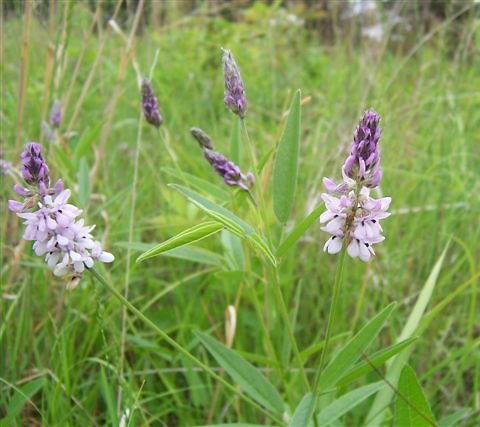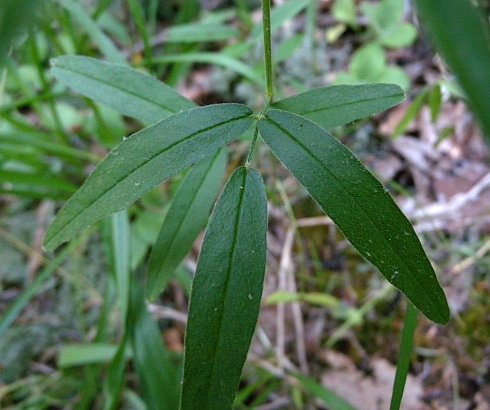Description: This perennial wildflower is 1-2½' tall, branching occasionally. The stems are terete and either glabrous or slightly pubescent. Alternate trifoliate leaves occur along the stems on petioles that are ½-2" in length. At the base of each petiole, there is a pair of narrowly lanceolate stipules less than ¼" long. The rather narrow leaflets are 1-3" long and ¼-¾" across; they are ellipsoid to oblong in shape and smooth along their margins. The upper surfaces of the leaflets are medium green and hairless (or nearly so). In each trifoliate leaf, the lateral leaflets are nearly sessile, while the terminal leaflet has a short petiolule (stalklet) at its base. Spike-like racemes of flowers about 1½–4" long develop from some of the leaf axils. These racemes are held more or less erect above the foliage on long naked peduncles about 3-6" long. The peduncles are glabrous or slightly pubescent. The flowers are arranged somewhat densely all around the raceme; they vary in color from blue-violet to white. Usually, the buds near the apex of a raceme are more blue-violet than the flowers in bloom below, which tend to be more white. Individual flowers are ¼" long, consisting of 5 petals, a short tubular calyx with 5 teeth, and the reproductive organs. The arrangement of the petals is typical for species in the Bean family: there is an upright banner and a pair of lateral wings that project forward to enclose the keel (consisting of two smaller petals).

The blooming
period occurs from early to mid-summer and lasts about 3 weeks. The
flowers are replaced by small seedpods (a little less than ¼" in
length) that are flattened and nearly circular in shape. The sides of
each pod have transverse wrinkles. Each seedpod contains a single seed.
The root system consists of a taproot.
Cultivation:
The preference is full or partial sun, mesic to dry conditions, and an
acidic soil that is sandy or rocky.
Range & Habitat:
The native Sampson's Snakeroot is occasional in southern Illinois,
while in the
rest of the state it is absent (see Distribution
Map).
Illinois lies
along the northern range limit for this flowering plant. Habitats
include mesic to dry prairies, sand prairies, sandstone glades, rocky
upland woodlands, savannas, and thinly wooded bluffs. This wildflower
benefits from occasional disturbance that reduces the encroachment of
woody vegetation.
Faunal Associations:
In general, very little is known about floral-faunal relationships for
this species. The flowers are pollinated primarily by bees, which seek
nectar and pollen. A Carder bee, Anthidium psoraleae,
is one of the bee visitors of the flowers; it is a weak oligolege
(specialist pollinator) of flowering plants in the Fabaceae (Bean
family). A similar species, Anthidium maculifrons,
may be another oligolectic visitor of the flowers. The caterpillars of
the moth, Cyclophora pendulinaria (Sweetfern
Geometer), have been observed to feed on Sampson's Snakeroot.

Photographic
Location: The
flowering plants were photographed by Keith & Patty Horn
(Copyright © 2009) at a prairie in Fayette County, Illinois. The
trifoliate leaf was photographed by the webmaster at the top of a
semi-shaded sandstone cliff in southern Illinois.
Comments:
Sampson's Snakeroot is a fairly typical example of a species in the
Bean family: it has trifoliate leaves and racemes of pea-like flowers.
The seedpods are perhaps its most unusual feature: they are nearly
circular in shape and contain a single seed. More typically, the
seedpods of species in this family are more elongated in shape and
contain several seeds. In Illinois, the closest relative of Sampson's
Snakeroot is Orbexilum onobrychis (Sanfoin), which
is found in habitats that are more moist (e.g., river-bottom prairies).
This latter species is larger in size (3-4' tall) than Sampson's
Snakeroot, its leaflets are more wide (often exceeding 1" across), and
its flowers are usually a deeper shade of blue-violet. Another similar
species, Psoralidium tenuiflorum (Scurfy Pea), has
palmately compound leaves with as many as 5 leaflets and the flowers of
its racemes are more loosely arranged on shorter peduncles. An older
scientific name of Sampson's Snakeroot is Psoralea
psoralioides.